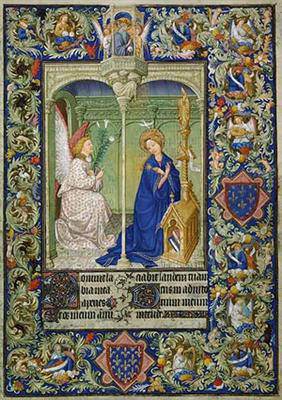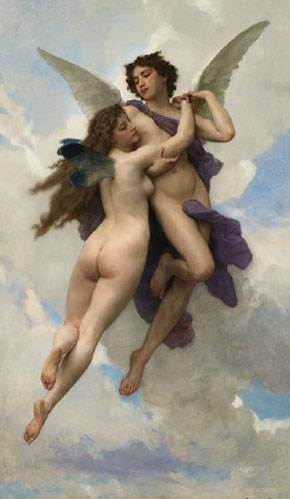
Belles Heures of Jean of France, Duc of Berry, 1405–1408/9
Herman, Paul, and Jean Limbourg (Franco-Netherlandish, active in France, by 1399–1416)
French; Made in Paris
Ink, tempera, and gold leaf on vellum
9 3/8 x 6 5/8 in. (23.8 x 16.8 cm)
The Cloisters Collection, 1954 (54.1.1)
image courtesy: www.metmuseum.org
The Belles Heures of Jean de France, Duc de Berry — On View at Metropolitan Museum
One of the most beautiful manuscripts in the world is the lavishly illustrated medieval prayer book known as the Belles Heures (Beautiful Hours). It was created by the Limbourg Brothers—three of the greatest illuminators in Europe—for one of the most famous art patrons of all time, Jean de France, duc de Berry (1340–1416).
March 2–June 13, 2010
]]>
March 2nd, 2010 – source: Metropolitan Museum
“The manuscript known as the Belles Heures has been a treasured highlight of The Cloisters—the Met’s branch museum devoted to medieval art and architecture — since 1954,” commented Thomas P. Campbell, Director of The Metropolitan Museum of Art. “In it are many magnificent illustrations of scenes from the Gospels and the lives of the saints, as one would expect in a book of private prayer. But also contained within this one manuscript are more brilliantly preserved paintings from the first decade of the 15th century north of the Alps than can be found collectively on the walls of all the major museums in Europe and North America. The number of images amazes us; their sheer beauty never fails to astonish. The great achievement of the Limbourg brothers—who were startlingly young when they created this manuscript—is the unique combination of clarity, luminosity, drama, and breathtaking technique with which they ornamented every page. The Belles Heures was truly the laboratory for the development of their artistic vision.”
The exhibition is arranged thematically, according to the sequence in which the sections appeared in the bound manuscript. It begins with 12 calendar pages, each of which is illustrated with a typical activity for the month at the top of the page and the related sign of the zodiac at the bottom. Other sections include readings from the Gospels, the Hours of the Virgin, the Hours of the Passion, and the Suffrages of the Saints, as well as pictorial histories of Saints Catherine, Jerome, and others. The exhibition ends with a prayer for travelers, in which the duc de Berry himself is portrayed on horseback leaving his castle with his retinue.
The brothers Herman, Paul, and Jean de Limbourg were born in the duchy of Guelders in the city of Nijmegen, today in the Netherlands. About 1398, Herman and Jean were apprenticed to a goldsmith in Paris. Their training was to have lasted six years, but was suspended—probably in November 1399—”because death was then about in Paris” (perhaps referring to the Black Plague). The Limbourgs were hired soon thereafter as illuminators by Philip the Bold, the duke of Burgundy. After Philip’s death in 1404, his brother Jean de France engaged them and retained their services for the rest of their lives. (The Limbourg Brothers died within months of one another in 1416.) The Belles Heures is one of three manuscripts that they are known to have worked on, yet it is the only complete manuscript attributed to them that was also entirely illuminated by them. Though small in scale—the book measures slightly less than 9–1/2 by 7 inches (23.8 x 16.8 cm)—the illustrations are monumental in impact, and its youthful artists succeeded in creating a masterpiece of luminous color, astonishing detail, and enormous appeal.
At the heart of a Book of Hours—the most popular genre of privately owned books of prayer in the Middle Ages—is the series of devotions known as the Hours of the Virgin. These include psalms, hymns, canticles, and prayers that were meant to be read during the eight canonical hours of the day. Many Books of Hours were illustrated, a factor that certainly contributed to their popularity. In the Belles Heures, each of the Hours of the Virgin is introduced with a glorious illumination, such as the Annunciation at Matins and the Flight into Egypt at Compline. Although piety may have been a factor for many patrons who commissioned such books, the sheer love of beauty was certainly the motivation for others. Jean de France already owned several Books of Hours when he commissioned the Belles Heures, and its range of illustrated stories was unprecedented.
The Belles Heures of Jean de France contains all the typical components of a French Book of Hours along with seven additional highly ornamented and richly illustrated sections. These insertions were the framework within which the Limbourg Brothers marshaled light, color, and realistic detail in the service of storytelling. Created over a three- to four-year period from 1405 to 1408/9, the Belles Heures is composed of 224 folios, or leaves, of the highest-quality vellum (calfskin) so skillfully prepared that each folio is translucent, and the text and decoration on one side can be seen from the reverse. Each page sparkles from the generous application of gold leaf in the border, and an unusually wide range of colors—including the brilliant and valuable ultramarine blue originating from Afghanistan—dazzle the eye.
Follow us on:


